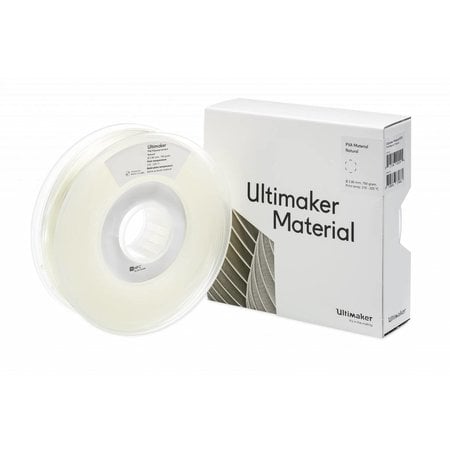UltiMaker PVA
| SKU: | 9732 |
| EAN: | 8718836374999 |
| Location Code: | GDS3P0R6 |
- Hoogwaardige service en support
- Eenvoudige mogelijkheid voor leasen.
- Gunstige verzendvoorwaarden en retourbeleid
- Fysieke showrooms op diverse locaties in Nederland
- Op werkdagen voor 14:00 besteld, binnen 2 werkdagen.
How to print with Ultimaker PVA
Ultimaker PVA (polyvinyl alcohol) is a 3D printing material commonly used to create water-soluble support structures to achieve complex geometries.
Note: The information provided here applies to Ultimaker PVA, similar quality cannot be guaranteed with third-party filaments.
Compatibility
PVA is specifically developed for dual-extrusion prints, which means that it is supported on both the Ultimaker S5, Ultimaker S3 and Ultimaker 3. On these printers you should print PVA with a BB print core.
| Printer | Compatible print cores / nozzles |
| Ultimaker S5 (Pro Bundle | BB 0.4, BB 0.8 |
| Ultimaker S3 | BB 0.4, BB 0.8 |
| Ultimaker 3 (Extended) | BB 0.4, BB 0.8 |
| Ultimaker 2+ (Extended) | Not supported (experimental) |
Note: Since Ultimaker PVA is used as a support material for dual-extrusion prints, no print profiles are developed for single-extrusion printers
Ultimaker PVA has optimised settings for the Ultimaker Pro Bundle, Air Manager and Material Station. This ensures a good end of filament and end of print experience in the Material Station and an optimal build environment with the Air Manager. Please make sure to use the latest version of Ultimaker Cura and ensure the firmware has the latest update.
We have extensively tested preconfigured Ultimaker Cura profiles for optimal results when printing PVA support structures in combination with a build material on the Ultimaker S5, Ultimaker S3 and Ultimaker 3. Below is an overview of the compatibility of PVA with other Ultimaker build materials.
1 Only possible for small prints. Larger prints may show warping in the build material
2 Dual combinations with TPU 95A may result in stringing and blobs on the surface of the print
The use of Ultimaker PVA in combination with PC and PP is not supported, due to insufficient adhesion between PVA and these materials, which will most likely result in print failure.
Recommended settings and configuration
Note: Always use the latest version of Ultimaker Cura and make sure that your 3D printer is updated with the latest firmware version to include the correct material profile for Ultimaker PVA.
Temperatures
Ultimaker PVA prints at a temperature of 215-225 °C, and a build plate temperature of 60 °C is required when printed as a single material. If PVA is printed as a support material, simply use the build plate temperature required for the accompanying build material.
Note: The correct temperatures are automatically used based on the printer, nozzle size, and profile you select in Ultimaker Cura.
Adhesion
Ultimaker PVA adheres well to the heated glass plate. However, the adhesion method may differ based on the accompanying build material.
We suggest applying a thin layer of glue (included in the accessory box of your Ultimaker) to the glass plate for PVA. For dual-extrusion prints, the adhesion method should be based on the accompanying build material.
When printing PVA as a single material, the default adhesion type is a brim. A brim is made of extra lines printed around the perimeter of the first few layers of your model to ensure successful adhesion to the build plate.
When printing PVA in combination with another material, we recommend using the adhesion method for the accompanying material. For the best adhesion and print quality, we recommend setting the ‘build plate adhesion type’ to Extruder 2 (PVA) in Ultimaker Cura.
After printing, let the build plate cool down and remove the print from the build plate. Next, the PVA can be dissolved according to the instructions on this page.
Print environment
Additional accessories are not required to create a stable printing environment for PVA. However, based on the accompanying build material, it may be necessary to use the front enclosure included in the Advanced 3D Printing Kit, if you are printing on the Ultimaker 3.
Furthermore, it is very important to handle PVA correctly when in use. Once opened, PVA filament will absorb moisture from the ambient environment. To minimise this, print in a room with an ambient temperature of below 28 °C and a relative humidity below 50%. Immediately after printing, always store the spool in a resealable bag with the supplied desiccant. When the material is not in use, we recommend storing it under the conditions described in our material storage guide.
Health and safety
Ultimaker PVA is safe to print when using the recommended temperatures listed in the table above. To ensure a comfortable and healthy working environment, we recommend 3D printing in a well-ventilated area.
For more information, download the safety data sheet for Ultimaker PVA here.
Help ons en andere klanten door het schrijven van een review












